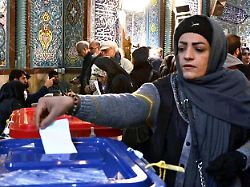Low voter turnout
Hardliners on the verge of victory in parliamentary elections in Iran
March 3, 2024, 11:24 a.m
Listen to article
This audio version was artificially generated. More info | Send feedback
In Iran, which is already extremely conservative, there are signs of a further shift in power towards religious hardliners. In the parliamentary elections they are ahead almost everywhere in the country, moderate forces are doing poorly. However, many are excluded as candidates in advance.
As expected, an alliance of ultra-conservative candidates is leading in Iran’s parliamentary election. According to initial results, the list of “trustees” headed by the Shiite scholar Hamid Rassai won 18 of 30 seats in Tehran, state media reported. The incumbent parliament speaker Mohammed Bagher Ghalibaf, who ran for the conservative list of the influential “Stability Front”, secured his entry into parliament.
There were also signs of a fundamentalist victory in other parts of the country. According to an analysis by the state news agency IRNA, supporters of the conservative camp in the rest of the country won at least 156 of the 290 seats in parliament. Reform politicians got 35 mandates here. There are different political currents within the camps, and the first power struggles are already becoming apparent. There will be runoff elections in some constituencies and also in Tehran because several candidates failed to win the required minimum number of votes.
Boycott calls and historically low voter turnout
Around 61 million people were called on Friday to elect a new parliament and the so-called Council of Experts, which will deal with his successor in the event of the death of the powerful religious leader. There has recently been little electoral mood in the capital Tehran. Many people have become disillusioned after failed reform attempts over the past decades and stayed away from the vote in protest. They were the first elections after the women-led protests in autumn 2022.
According to unofficial data, voter turnout in Tehran was only 24 percent, as pro-government media reported. Nationwide, 41 percent of voters went to the polls – a historically poor turnout. Even in the Shiite pilgrimage city of Qom, Iran’s religious center of power, voter turnout was only around 50 percent. The numbers cannot be independently verified.
Observers have already expressed doubts about voter turnout, which is roughly at the level of the last election in 2020. The mass protests in autumn 2022 reflected the enormous discontent in society, said Iran expert Azadeh Zamirirad from the Science and Politics Foundation (SWP). “The actual number of people who see elections as a channel for political change is therefore likely to be significantly lower.”
Iranian media: “Beginning of an era of radicalization”
The media even declared defeat for moderate-conservative groups. The online newspaper “Entekhab” entitled an editorial with the headline: “Beginning of an era of radicalization” and described the hardliners’ expansion of power. Its leading candidate, Hamid Rassai, was disqualified in the last election, “perhaps because of his intransigent, harsh statements,” the authors wrote. “In the absence of the silent majority, it is mostly the minorities who take part in the elections,” the editorial continued.
Meanwhile, Iran’s currency plunged to a record low. In the exchange offices, the unofficial euro rate reached more than 640,000 rials for the first time on Saturday. Over the past decade, the national currency has lost more than 93 percent of its value amid political isolation, international sanctions and an uncertain future.
Many candidates excluded before the elections
The political system of the Islamic Republic has combined theocratic and republican elements since the 1979 revolution. The 290 seats in Parliament are elected by the people every four years. Candidates do not enter the race with parties, but rather organize themselves through lists. The current legislative period ends on May 26th.
The Guardian Council, an ultra-conservative control body, decides in advance on the ideological suitability of politicians. As a result, citizens can mainly only choose from a group of candidates who are loyal to the system. This time the Guardian Council excluded around 5,000 applicants. Nevertheless, a record number of 15,000 Iranians ran for office.
Expert advice could determine successor to religious leader
In addition to the parliament, the Council of Experts was also elected. The body, which is elected for eight years, includes 88 Shiite clergy who determine the successor to the religious leader in the event of his death. Ayatollah Ali Khamenei is the most powerful man in Iran; the head of state will be 85 years old in April. Only 144 candidates were approved for the council. The low number was justified by strict theological requirements. Before the elections, the disqualification of moderate former President Hassan Ruhani, who has been a member of the Council of Experts for more than 20 years, caused criticism.
The Parliament is Iran’s legislative institution. The real power, however, is concentrated in the state leadership with religious leader Khamenei at the top. The president is also elected by the people as head of government every four years and appoints the ministers. The Security Council also has extensive powers. Iran’s elite military force, the Revolutionary Guards (IRGC), has expanded its influence at all levels in recent decades and has become an economic empire.
“Now even loyal conservatives like former President Ruhani or the current parliament speaker Ghalibaf are finding it difficult to gain a foothold in power politics,” explained political scientist Zamirirad. “This indicates that the state leadership no longer wants to leave anything to chance in this critical transition phase and that the space in favor of the hardliners is even narrower than before.”
